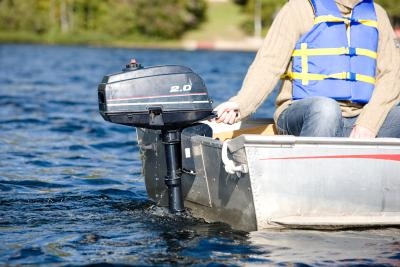
Marine outboard motors which have been used for extended trolling and idling often build up carbon deposits inside the combustion chamber. Carbon deposits result from the incomplete burning of gasoline, which leaves behind soot and varnish that collects on the valves, cylinder walls and piston head. Heavy carbon buildup can cause pinging, a symptom of pre-ignition, which results from the after-glow of heated particles in the cylinder. Intake and exhaust ports can also carbon-up, causing overheating problems and sporadic detonation. De-carbonizing an outboard remains one of the best maintenance procedures to insure a clean-running, non-stumbling marine engine.
Hook the outboard motor up to a muff flushing device or submerge the lower unit in a 55-gallon barrel of water. If the boat is moored or docked, leave it in the water. You can not run the motor without fresh water intake to cool it. Unfasten the top engine cover snaps and open it up. Remove the spark plug wire (or wires) and use a socket to remove the spark plug. Consult your outboard repair manual for the correct heat range for your motor. Make certain the plug does not exceed the recommended heat range.
Clean the spark plug with a wire brush and carburetor cleaner. Remove all carbon deposits around the electrode. Replace any plug that looks discolored and crusty, shows white deposits, or appears to have a deformed or worn electrode. Reinsert the spark plug and tighten it with a socket. Reconnect the plug wire.
Use a screwdriver or socket to remove the air cleaner element from the engine. Replace the air cleaner element at this time, if you desire. Start the motor and let it warm up to normal operating temperature. Manually increase the throttle until you have a fast idle. Point the spray tube from a can of internal engine cleaner at the throat and throttle plate of the carburetor and release a constant stream of cleaner. The motor might run rough, but continue with a heavy spray until the motor stumbles and quits.
Let the internal engine cleaner work for at least 30 minutes. The internal engine cleaner acts like oven cleaner, in that it will loosen carbon deposits and soften up gum and fuel varnish. Return to the engine and restart it. If it does not restart, use a socket to remove the spark plug and turn the engine over to blast the engine cleaner out of the cylinder. Replace and re-tighten the plug. Start the engine and allow all white billowing smoke to exit the exhaust.
Raise the motor to a fast idle again, and deliver more engine cleaner into the carburetor throat. Do not let the engine die; stop the cleaner flow and rev the motor a few times to clear out all cleaner vapors. The motor will stabilize and begin to run much smoother. Replace the air cleaner element, using a screwdriver or socket. Replace the engine cover and refasten the snaps.